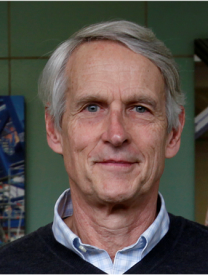Professional Appointments:
2009 – Mary Amanda Wood Professor of Physics and Astronomy, University of Pennsylvania
1982-2009 Professor, Department of Physics and Astronomy, University of Pennsylvania
1981 Scientific Associate, CERN
1978-1982 Associate Professor, Department of Physics and Astronomy, University of Pennsylvania
1978 Visiting Scientist, KEK National Laboratory
1974-1978 Assistant Professor, Department of Physics and Astronomy, University of Pennsylvania
1973-1974 Associate Physicist, Brookhaven National Laboratory
1971-1973 Postdoctoral Fellow, Brookhaven National Laboratory
1966 B.S. Physics Haverford College
1972 Ph.D. Physics Stanford University
My research focuses on studies of elementary particles with the goal of understanding Nature at the most elemental level. This includes both identifying the most “fundamental particles” and studying their interactions. Earlier in my career, I studied the interactions of neutrinos in several different experiments at Brookhaven National Laboratory; highlights included the first observation of a charmed baryon, the first quantitative measurements of the elastic scattering of neutrinos from protons, and refined measurements of the elastic scattering of neutrinos from electrons. These results played an important part in establishing the “Standard Model” of elementary particles, the current, highly successful theory which explains almost all known particle interactions.
Subsequently, I became involved in helping to build the CDF detector at Fermilab in Batavia, Illinois, and have participated over nearly twenty years in a wide range of measurements. Highlights of this research included discovery of the top quark and measurements of its mass, as well as early searches for a new class of “Supersymmetric Particles” which many physicists expect to exist, but which have not yet been observed.
Beginning in 1993, I became involved in the ATLAS experiment at the Large Hadron Collider with a focus on designing and delivering the on-detector electronics for the Transition Radiation Tracker, and critical element of the ATLAS tracking system which also provides electron identification. With a team of instrumentation specialists, graduate students and postdoctoral fellows, the Penn ATLAS group delivered all of the on-detector electronics for the TRT, provided the corresponding data acquisition system and also played a major role in commissioning the off-detector electronics. A series of graduate students and postdoctoral fellows from Penn have taken nearly full responsibility for the operation of the TRT data acquisition and electronics.
My physic interests in ATLAS have focused on searches for the higgs (and studies of it subsequent to its discovery) as well as searches for exotic new particles and Supersymmetric particles. More specifically, my current and recent research has focused on:
- Observation of the Higgs in the gamma gamma final state
- Studies of vector boson fusion production of Higgs in the ZH, H -> gamma gamma
- Measurement of H -> ZZ
- Search for new heavy Z’ bosons in the tau tau final state
- Search for Supersymmetry in the diphoton + missing Et final state
Future research topics, while far from being firmly established, are likely to include studies of H -> tau, tau and searches for Supersymmetry and other Exotic particles. I continue to be very involved in the operation of the TRT detector and am involved in upgrades of both the liquid argon calorimeter electronics and electronics for a new silicon tracking detector.
I typically have three graduate students and a postdoctoral fellow working with me on these topics. I intend to add several graduate students in the near future.
Fall 2010 Sabbatical to focus on ATLAS experiment at the LHC
Spring 2010 Physics 151, Introduction to Electromagnetism
Fall 2009 teaching relief as Principal Investigator for High Energy Physics DOE grant (10 faculty)
Spring 2009 Physics 151, Introduction to Electromagnetism
Fall 2008 teaching relief as Principal Investigator for High Energy Physics DOE grant (10 faculty)
Spring 2008 Physics 522, Introduction to Elementary Particle Physics
Fall 2007 teaching relief as Principal Investigator for High Energy Physics DOE grant (8 faculty)
Spring 2007 Physics 522, Introduction to Elementary Particle Physics
Fall 2006 teaching relief as Principal Investigator for High Energy Physics DOE grant (10 faculty)
Search for high mass dilepton resonances in pp collisions at sqrt{s}=7 TeV with the ATLAS experiment, ATLAS Collaboration (Georges Aad et al.), Submitted to Physics Letters B, Mar 2011. 7 pp
Search for high-mass states with one lepton plus missing transverse momentum in proton-proton collisions at s=7 TeV with the ATLAS detector, ATLAS Collaboration (Georges Aad et al.), submitted to
Physics Letters B (8 Mar 2011) 10 pp.
Search for stable hadronising squarks and gluinos with the ATLAS experiment at the LHC, ATLAS Collaboration (Georges Aad et al.), submitted to PLB (10 Mar 2011). 9 pp.
Search for supersymmetry using final states with one lepton, jets, and missing transverse momentum with the ATLAS detector in sqrt{s} = 7 TeV pp, Atlas Collaboration (Georges Aad et al.), Phys. Rev. Lett.
106, 131802 (2011) 5pp.
Measurement of the inclusive isolated prompt photon cross section in pp collisions at sqrt(s) = 7 TeV with the ATLAS detector, Atlas Collaboration (Georges Aad et al), Phys. Rev. D 83, 052005 (2011) 19 pp.
Search for Massive Long-lived Highly Ionising Particles with the ATLAS Detector at the LHC, Atlas Collaboration (Georges Aad et al), Phys. Lett. B698 (2011) 353-370 (2 Feb 2011)
Search for Diphoton Events with Large Missing Transverse Energy in 7 Main.TeV Proton-Proton Collisions with the ATLAS Detector, Atlas Collaboration (Georges Aad et al), Phys. Rev. Lett. 106, 121803 (20 Dec 2010)
Measurement of the W -> lnu and Z/gamma* -> ll production cross sections in proton-proton collisions at √s=7 Main.TeV with the ATLAS detector, Altas Collaboration (Georges Aad et al), JHEP 12(2010) 060 (11 Oct 2010)
Studies of the performance of the ATLAS detector using cosmic-ray muons, Atlas Collaboration (Georges Aad et al), EPJC 71 (2011) 1593 (1 Dec 2010)
Measurement of the W -> lnu and Z/gamma* -> ll production cross sections in proton-proton collisions at A

